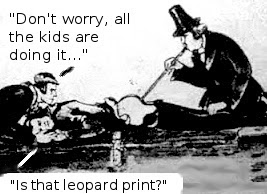NASCAR lately has handed out some stiff penalties to competitors for infractions. Yet the Bleacher Report tells us that among the top quotes in NASCAR history there is much evidence that rule-following may be the exception for drivers:
“If you ain’t cheatin’, you ain’t tryin'” is an old NASCAR expression. Junior Johnson had this to say about his creativity when it came to building cars:
“I loved the game. Maybe I’d have four of five new things on a car that might raise a question. But I’d always leave something that was outside of the regulations in a place where the inspectors could easily find it.
“They’d tell me it was illegal, I’d plead guilty, and they’d carry it away thinking they caught me. But they didn’t check some other things that I thought were even more special.”
BR also cites driver Darrell Waltrip in 1976 after his team was caught cheating with nitrous oxide.
If you don’t cheat, you look like an idiot; if you cheat and don’t get caught, you look like a hero; if you cheat and get caught, you look like a dope. Put me where I belong.
Waltrip’s best story might be the time he was caught filling his car frame with BBs to cheat the weight test before a race. Because cars weren’t weighed afterwards he simply pulled a plug and all the weight would disappear on the track without detection. Unfortunately one day the balls jammed. The BBs sat in his car, keeping him at regulation weight, until Waltrip’s car entered the pit. Then, as he approached the other crews, the entire payload came free and pelted them.
That story comes from Popular Mechanics’ article called “The Greatest Cheats in NASCAR History,” which has many other examples:
- Fuel capacity: Yunick inflated a basketball in the tank during tests, then deflated it before the race
- Fuel capacity: Yunick quadrupled the 11 ft fuel line diameter to carry 5 extra gallons
- Aerodynamics: Johnson’s crew chief Knaus altered rear window angle
- Weight: Flock painted wood to look like metal roll bars
I especially like the fuel line cheat as Yunick argued the line was not technically part of the tank and therefore should not be included in measurement of capacity. Popular Mechanics also quotes a famous cheater who thought “stock” cars meant a challenge to make some stock “better” than others.
“It can be frustrating,” says Chad Knaus, crew chief for four-time champion Jimmie Johnson…. “But it would be more frustrating to give up trying to make our car better.”
I suppose you could excuse failure to follow a rule when a rule is first introduced. There might be confusion and not everyone would be able to interpret the same. That is especially believable when NASCAR found that almost no one passed:
To help cut down on cheating, NASCAR introduces body templates, which race cars must conform to, Prior to the Firecracker 400 at Daytona, 49 of 50 cars entered flunk initial tech inspection.
But that sad tally was decades ago in the 1960s, as reported by Something About Everything Racin’, which also retells a story of Petty’s winning engine. The cylinders apparently had wax in them before a race to pass inspection. During the race it melted so after the race the engine measured much larger than the maximum allowed; it went from just over 350 to 392 cubic inches. At the end of the race, despite all the penalties and warnings, it seems that the winners in NASCAR are cheating all the time.
The names of those caught skirting the rule book read like a “Who’s Who” in NASCAR history: Tim Flock, Smokey Yunick, Junior Johnson, David Pearson, Bobby Allison. Richard Petty, Roger Penske, Jack Roush, Ray Evernham … the list goes on and on, almost as if it’s some kind of badge of honor.
Indeed, the badge of hacking just has been bestowed to teams No. 14, No. 3 and No. 18 according to a NASCAR press release:
The No. 14 team in the Sprint Cup Series was found to be in violation of Sections 12-1 (actions detrimental to stock car racing); 12-4J (any determination by NASCAR officials that the race equipment used in the event does not conform to NASCAR rules detailed in Section 20 of the NASCAR Rule Book); and 20-2.1J (unapproved open vent hose inside of the car).
Imagine if computer security regulations had something like “Sections 12-1 (actions detrimental to stock car racing).” Actions detrimental to the industry? The FTC is probably the closest thing.
That vague catch-all 12-1 rule was really meant to help prevent fist fights and other unsportsmanlike behavior. Ironic, since some say the reason NASCAR became so popular in America was a 1979 televised fight.
Oh, and note the NASCAR typo. That should be rule 20A-2.1J. Is the fine removed if there’s no 20-2.1J?
Anyway, with all that background, I’m going to take a guess and say that the vent hose was intentionally routed inside to reduce air resistance. A fairly boring hack and the finding doesn’t seem to be an isolated instance.
The No. 3 team in the Nationwide Series was found to be in violation of Sections 12-1; 12-4J and 20A-2.1J (unapproved open vent hose inside of the car).
As fun as it is to read the infraction reports and the odd-ball excuses or theories of disobedience from the teams, it really just makes me yearn for something more meaningful in development and innovation — where’s the bump in the power to efficiency ratio we could all use?
It will be years before the IndyCar innovation trickles down into NASCAR, despite all the stories of cheating. I wish the car racing regulatory bodies would just speed up the process and let someone race a diesel again.
Now THAT was an impressive hack that translated directly to stock benefit.





